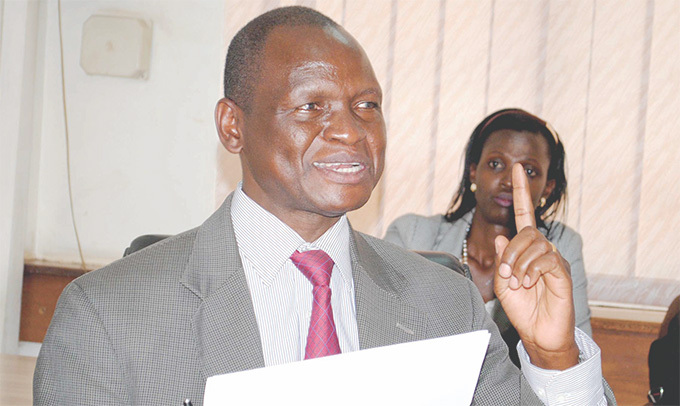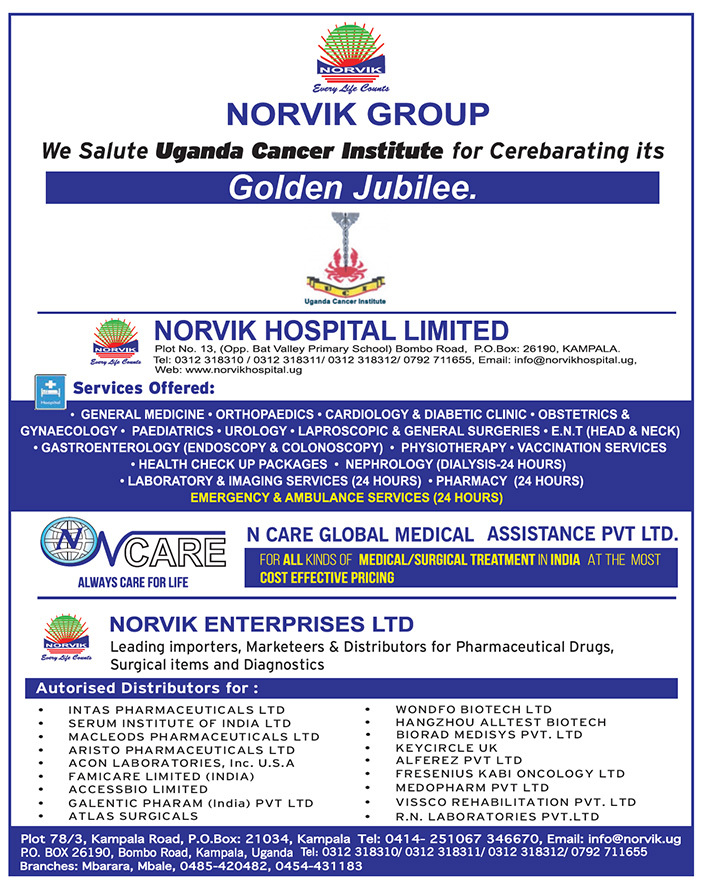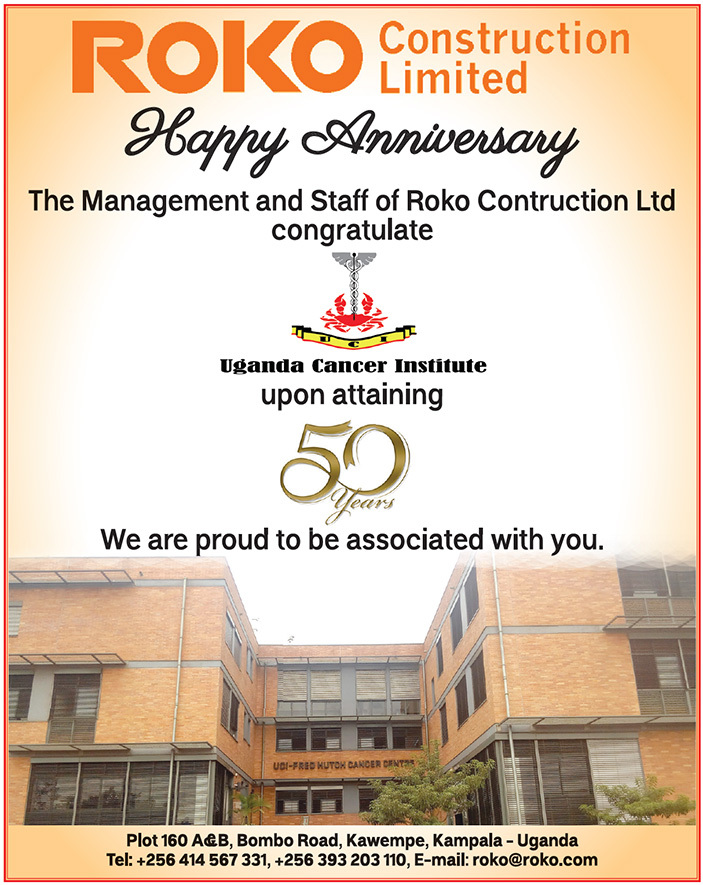Cancer institute: Serving since 1967
Aug 30, 2017
These achievements started in 1967, when UCI, originally called the lymphoma treatment centre, opened its doors to Ugandans with 20 beds.

The Uganda Cancer Institute has not only been instrumental in healthcare services for cancer cases in Uganda, but has also conducted research and contributed to the increase of human resource in cancer treatment.
These achievements started in 1967, when UCI, originally called the lymphoma treatment centre, opened its doors to Ugandans with 20 beds.
At the time it was basically treating childhood lymphoma, predominantly Burkitt lymphoma, the most common childhood lymphoma in Uganda and endemic to tropical Africa.
This specific cancer derives its name from an Irish surgeon missionary, Dr Dennis Burkitt, who worked in Uganda in the late 1950's and pioneered the first successful use of chemotherapy combination.
Burkitt described and developed treatment for childhood lymphoma, a type of cancer that was ravaging many parts of Africa. In recognition of his work, it was eventually named Burkitt lymphoma, after him.
In 1965, the National Cancer Institute (NCI) in the US partnered with Makerere University to conduct chemotherapy research and began by supplying funding and researchers.
Two years later, the project matured into the Uganda Cancer Institute under the stewardship of John Ziegler, an American and Burkitt was one of the doctors that worked at Makerere's Mulago Medical School. Ziegler headed the institution from 1967-1972.
The centre also expanded and doubled the number of its beds when the Solid Tumor Center was added to focus research on Kaposi's sarcoma and liver cancer.
With research in other types of cancer, UCI became a leading international medical research centre in its areas of specialisation during the 1960s and early 1970s. With such an impressive reputation, it established collaboration with the National Cancer Institute (NCI) in Bethesda, Maryland.
Sadly, the centre suffered a setback in 1972 when nearly all of NCI's scientists left following the expulsion of Ugandan Asians by former president of Uganda Idi Amin.
Fighting the cancer scourge in Uganda
The expulsion of Ugandan Asians was a huge setback. However, this also gave an opportunity for a Ugandan to rise to the function — Prof. Charles Olweny, a researcher and former student of Burkett NCI in the US, returned to become the first native director of UCI.
Ten years later, he was also forced to leave the country again following the overthrow of Amin, leaving the leadership of UCI in the hands of Prof. Edward Katongole-Mbidde.
When Katongole-Mbidde left UCI to become the director of the Uganda Virus Research Institute in 1995, Dr Jackson Orem took over the leadership.
 Orem addressing the media during the World Cancer Day recently
Orem addressing the media during the World Cancer Day recently
What is cancer?
Dr Amos Mwaka, a medical oncologist at Nsambya Hospital and lecturer of post-graduate medical education at the hospital, defines cancer as an abnormal growth of cells in any organ.
"Cells are made up of DNA, which relays information of growth, multiplication and death of cells through programmed cell death (PCD)," he explains.
When this disorder occurs, the growth of cells gets into disarray. Mwaka explains that the full growth cycle of a cell is made up of six stages. If cells do not reach their full stage, they become autonomous, grow uncontrollably and eventually become tumors.
"Some of them reach a certain stage, but because they are not receiving messages from the DNA, they decide to go their own way. These are what are called cancer cells," he says.
Smoking is a risk factor for most of the cancers because it contains nicotine and other chemicals which form adducts.
"Adducts attach themselves onto the DNA which is found inside every cell and is responsible for the multiplication of cells," Mwaka explains.
This attachment causes a distortion in the message relayed by the DNA, which in turn causes the growth of cells to go into disarray. This disarray culminates in cancer.
"When cells grow and meet each other, they are supposed to stop growing, however, with cancer, cells they continue to grow over each other. They even grow and break the skin.
Cancer in Uganda
Statistics from the UCI indicate that the institute receives over 200 cancer patients daily.
The common types of cancers in Uganda are cervical cancer, which affects 48 per every 100,000 women. This is three times higher than the global average estimate of 15.8 per 100,000.
Other prominent cancers are prostate cancer that affects 45 per every 100,000 men, breast cancer that affects 45 per every 100,000 women and Kaposi Sarcoma, which affects 35 for every 100,000.
"Kaposi sarcoma for example, which was rare in the 1960s is on the rise today because it is related to HIV/AIDS. We also have seen cancer of the oesophagus, bladder and lungs increase due to the use of tobacco," Prof Charles Olweny, the board chair of UCI, said.
Olweny who was speaking during the recently joint international conference on cancer and palliative care at the Commonwealth Resort Muyonyo in Kampala organised by UCI and the Palliative Care Association of Uganda (PCAU) together with the Aga Khan University Hospital Nairobi (AKUHN), called for the ban on cigarette smoking saying tobacco is the only consumer product that kills 50% of its users.
According to the Prime Minister, Dr. Ruhakana Ruganda, addressing cancer needs a collective effort by various stakeholders such as service providers, advocates, affected patients, families, educators and development partners.
"Cancer is a big problem affecting people of any status. We cannot address it alone, therefore, your commitment is indispensable," he says.
Dr. John Weru a consultant specialist at AKUHN says there is need to address pain associated with cancer.
As UCI continues to fight cancer, it has partnered with international research centres to conduct collaborative projects, just like it did in the 1960s, when it started.
CLICK HERE FOR MORE ON THIS ARTICLE
****************************
Tale of cancer survivor
By Jacky Achan
John Mukiibi 25, a fish monger in Kampala outskirts of Busega, had always fancied circumcision. It is a procedure he always talked about with his peers on how it was trendy and had health benefits. However, he did not have money to carry out the surgery.
In 2013, Mukiibi was found to have a urinal bladder defect. He was passing yellow urine and, among things, doctors encouraged him to get circumcised.
‘‘I was asked to go for treatment and then after one month go back for circumcision,'' Mukiibi says.
Luckily for Mukiibi about that time, Makerere University medical practitioners came to his locality to conduct a mass circumcision exercise free of charge. This was his chance.
Mukiibi was among the 17 people circumcised on that day in Busega by the Makerere University Joint AIDS Programme (MJAP) Voluntary Male Medical Circumcision (VMMC) team.
 Mukiibi (centre) is still undergoing treatment at the cancer institute
Mukiibi (centre) is still undergoing treatment at the cancer institute
Slow recovery
Mukiibi had hoped for quick healing like other men who have undergone circumcision. But of the 17 people circumcised in Busega, he was the only one troubled and returned to hospital.
After the surgical procedure, Mukiibi says all seemed well until he noticed that his blood could not clot.
‘‘The healing process took so long and the bleeding persisted despite numerous trips to the health facility near me where I got circumcised,'' he says.
Worried, he decided to reach out to the MJAP team that conducted the procedure and he revealed to them the challenge he was facing.
Keen to establish the cause of the continuous bleeding, MJAP paid for Mukiibi to be taken to Platinum Hospital in Wandegeya, Kampala, where they run a number of tests, including bone marrow analysis.
Mjab was meeting all the costs as is their practice for any procedure that goes wrong. The tests and admission fees alone cost over sh7m.
Sadly, the tests were to reveal that Mukiibi had cancer of the blood, a condition known as leukaemia, which hampers the ability of the blood to clot. Mukiibi was shocked to learn that he was suffering from cancer.
‘‘It was the first time I was hearing about a condition called leukaemia. Apart from the constant headaches, I had never really felt any pain or any sign of sickness,'' Mukiibi says.
Convinced about the turn of events, MJAP had by now taken him under their care.
He was being cared for at Makerere University Hospital. The university doctors kept tabs on him to make sure he is fine.
But with no positive results, he was later referred to the Uganda Cancer Institute at Mulago Hospital, where he is still undergoing treatment.
Early detection
Mukiibi, who sells fish at a market stall in Busega, says some of his friends are always hinting circumcision led to his current condition.But he thinks otherwise. ‘‘Circumcision saved my life. I was lucky that leukaemia was diagnosed at an early stage, where it can be treated without me having to undergo chemotherapy,'' Mukiibi says.
Dr Robert Ssooka, the VMMC co-ordinator at MJAP, says the case of Mukiibi is an unusual one.
‘‘We have circumcised over 60,000 men and this was the first time we were encountering this case,'' Ssooka reveals. Even the health ministry was drawn to look into his plight.
Understanding leukaemia
Dr Henry Ddungu, a consultant at the Uganda cancer institute in Mulago Hospital and a specialist in blood medicine, explains that leukaemia is cancer of the blood cells.
It starts in blood-forming tissue, usually in the bone marrow (the spongy tissue found inside the bones).
It then leads to the over-production of abnormal white blood cells, the part of the immune system which defends the body against infection.
Ddungu says to understand leukaemia, you need to understand the normal process of blood formation which are from three cell lines (the red blood cells, white blood cells and platelets).
He says red blood cells carry food and give energy to the body, white blood cells fight infections and help the body to heal, while the platelets help us stop bleeding within the expected time. Ddungu says leukaemia affects mostly the white blood cells.
‘‘They can be many in the bone marrow to the extent that normal cells do not form. The abnormal cells then sit in the bone marrow, leading to leukaemia,'' he says.
Types of leukaemia
Ddungu says leukaemia is either acute or chronic, but is not among the top five cancers in the country.
Leukaemia is not common in the country, making only 2-5% of all the cancers in the country, but he warns it should not be taken lightly.
‘‘It is a very serious disease and has to be treated by experts,'' he says.
Signs of leukaemia
Dr Ddungu says when faced with cases of abnormal bleeding either from the nose, skin or any other area of the body, seek medical advice and evaluation.
He says: ‘‘Do not take these signs lightly or even blame it on witchcraft as others would like to do. Get medical evaluation to ensure you catch the condition early.''
Bleeding is due to lack of platelets in the body.
Ddungu says when you see any of these signs, visit a specialist. You will need to do further tests to classify whether it is acute or chronic leukaemia.
Testing for leukaemia
Ddungu says they mainly carry three types of tests. This includes the bone marrow test, genetics test and normal blood test.
This can also be through ultra sound and heart tests.
He says acute leukaemia is aggressive, but is not classified in stages like other cancers. It only gets treated when seen.
On the other hand, chronic leukaemia can be in stages and affects mostly adults and the elderly but is equally treatable.
Leukaemia is often found when a doctor orders blood tests for an unrelated health problem or during a routine checkup.
Even when symptoms are present, they are often vague and non-specific.
So if you go for circumcision you might not be aware of the condition. ‘‘You will only know after the procedure and further investigations when the bleeding does not stop,'' Ddungu explains.
Treatment
Dr Henry Ddungu, a consultant at Uganda cancer institute in Mulago Hospital, says with leukaemia, there is a possibility of survival. ‘‘Ninety percent of children with leukaemia cure and even the adults do cure with modern treatment options available,'' he says.
He adds that even chronic leukaemia is treatable and curable once given the right diagnosis and treatment.
‘‘Some cases of leukaemia are aggressive and can be challenging, but never lose hope unless the doctor tells you so,'' he says.
For Mukiibi having discovered his case of leukaemia early, he is still on treatment and he is on the path to getting completely healed. ‘‘Every six months, I return to hospital for treatment and monitoring to see if the cancer percentage has gone down, right now I am at 27 and I am okay,'' he says.
Dr Barbara Nanteza, the national co-ordinator of VMMC at the health ministry, says Mukiibi's case is one of success, where all parties had to go beyond the call of duty.
‘‘It is beyond just circumcision. We are meant to transform lives and that is what health services should be all about in the country,'' she says.
ADVERTISERS


